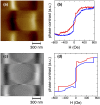Magnetic vortex chirality determination via local hysteresis loops measurements with magnetic force microscopy
- PMID: 27426442
- PMCID: PMC4947910
- DOI: 10.1038/srep29904
Magnetic vortex chirality determination via local hysteresis loops measurements with magnetic force microscopy
Abstract
Magnetic vortex chirality in patterned square dots has been investigated by means of a field-dependent magnetic force microscopy technique that allows to measure local hysteresis loops. The chirality affects the two loop branches independently, giving rise to curves that have different shapes and symmetries as a function of the details of the magnetisation reversal process in the square dot, that is studied both experimentally and through micromagnetic simulations. The tip-sample interaction is taken into account numerically, and exploited experimentally, to influence the side of the square where nucleation of the vortex preferably occurs, therefore providing a way to both measure and drive chirality with the present technique.
Figures






References
-
- Bader S. D.. Opportunities in nanomagnetism, Rev. Mod. Phys. 78, 1 (2006).
-
- Barthelmess M., Pels C., Thieme A. & Meier G.. Stray fields of domains in permalloy microstructures - Measurements and simulations, J. Appl. Phys. 95, 5641 (2004).
-
- Bohlens S. et al.. Current controlled random-access memory based on magnetic vortex handedness, Appl. Phys. Lett. 93, 142508. (2008).
-
- Hrkac G., Keatley P. S., Bryan M. T. & Butler K.. Magnetic vortex oscillators, J. Phys. D: Appl. Phys. 48, 453001 (2015).
-
- Kim S.-K., Lee K.-S., Yu Y.-S. & Choi Y.-S.. Reliable low-power control of ultrafast vortex-core switching with the selectivity in an array of vortex states by in-plane circular-rotational magnetic fields and spin-polarized currents, Appl. Phys. Lett. 92, 022509 (2008).
LinkOut - more resources
Full Text Sources
Other Literature Sources

